This article on the Wickliff Newell family appeared in last Spring’s “Now & Then” newsletter of the South Whidbey Historical Society.
A HARDSCRABBLE LIFE ON SOUTH WHIDBEY YIELDS SUCCESS
Logging, farming and fishing were the three main occupations of South Whidbey when early American and immigrant pioneers settled here in the mid and late 1800s and early 1900s.
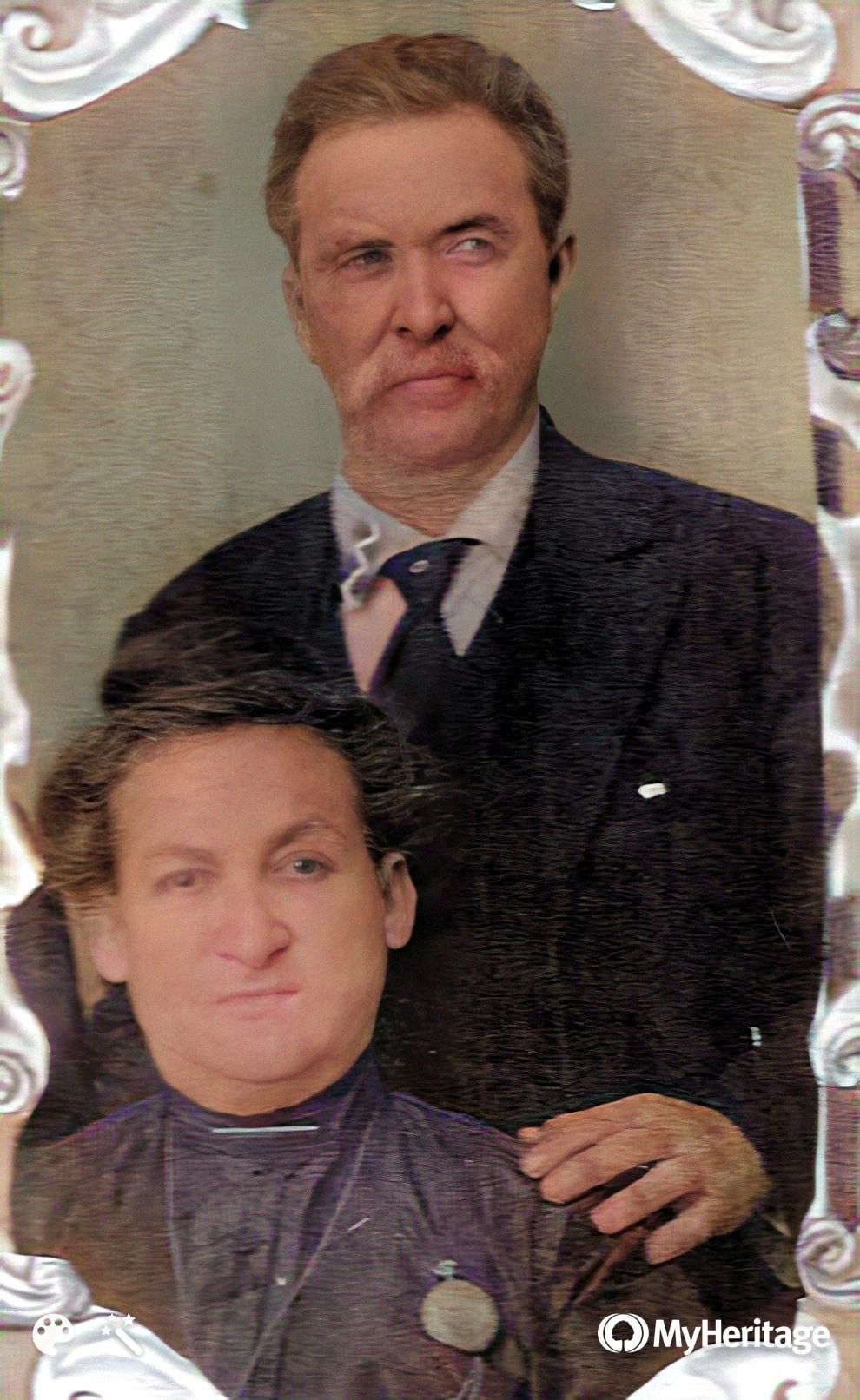
A colorized photo of the Newells.
Some families, however, carved out a living in some rather unique occupations. Consider the Newell family who came to South Whidbey in 1891.
Wickliff(e)* ‘Wick’ Newell was as close to a renaissance man as they come. At various times in his life, he had been a Union soldier, carpenter, buffalo hunter, scout for Buffalo Bill Cody, sharpshooter, surveyor, postmaster, hotel owner, newspaper founder, farmer, census manager, and trout hatchery owner.
Wick was born in Ohio in 1846, the youngest of 14 children. When he was 16 he tried to enlist in several Wisconsin regiments in the Union Army during the Civil War, but was turned down for being too young.
Journeying to Iowa, he was successful and joined Company F of the Iowa 4th Cavalry when he was 17 years and 3 months old. He saw action in several battles, including a unique skirmish in Memphis, TN in 1864 when Confederate General Nathan Bedford Forrest (who later headed the KKK) rode his horse into the Hotel Gayosa to attack three Union generals sleeping there.
In a 1931 newspaper article interview in the Des Moines Register, Wick recounted the incident: “We were sleeping near the hotel in our tents when the raid became known. We jumped out in our nightshirts, grabbed our guns and went at it…
“Guns flashed, men fell, and finally General Forrest and his men retreated from the town,” he said.
The Iowa 4th followed General Wilson through Tennessee, Alabama and finally Georgia, where Wick engaged in a last battle in Macon, GA… some three days after General Lee had surrendered at Appomattox, VA as the news was slow to reach them.
After the war, Wick became a buffalo hunter for the railroad–in other words, a plainsman. If this sounds familiar to a later resident of Bay View — Paul Cunningham — it very much is.
Both men were born in 1846 as was their one-time employer, William “Buffalo Bill” Cody.
Wick served as a scout for his traveling Wild West Show for a brief time as they crossed through land of various Native American tribes. (Wick spoke three tribal languages.)
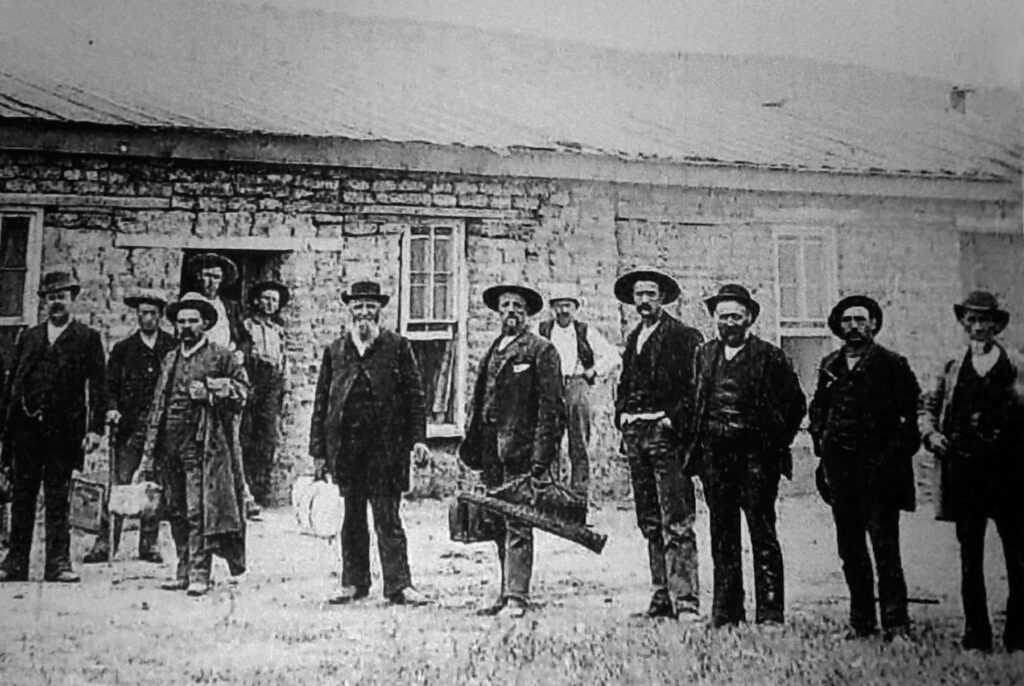
William Frederick ‘Buffalo Bill’ Cody in foreground, center, with Wick in the background in a white hunting helmet and two unidentified men in front of the Newell sod hotel in Wray, CO. Circa 1885.
Cunningham worked for a short time in Cody’s traveling Wild West Show as a sharpshooter and moved to Bay View in 1905, whereas the Newells arrived in 1891.
On Jan. 1, 1867, at the age of 21, Wick married 16-year-old Mary “Ellen” Lawver (or Lauver) from Minnesota. Their first child, Cora, was born in October that year in Ohio.
At age 24, Wick went back to the home of his parents who had relocated to Moline, Illinois directly across the Mississippi River from Davenport, Iowa. In the 1870 census he is listed as working with his father as a fisherman (though likely engaged in trout aquaculture) — an interest that would later be put to a related use when he moved to South Whidbey.
In 1873 the family moved to newly formed Furnas County, Nebraska near the Kansas border. Wick was elected as the first Furnas County Treasurer and also became postmaster of Green Springs, Nebraska.
The new county prospered until grasshoppers devoured crops, fruit trees and every green thing. Many settlers moved on to find better prospects. By 1880 the Newells had moved a little to the east to the town of Orleans in Harlan County, Nebraska. Wick is listed as a carpenter by trade on the 1880 census, as well as a postal clerk.
The Newells moved again by 1882 to a new town dubbed ‘Wray’ in Colorado just over the border from Kansas. Wick built a sod hotel and a little store called the Newell House which he ran with relatives. He is considered one of the early town founders and helped to survey it.
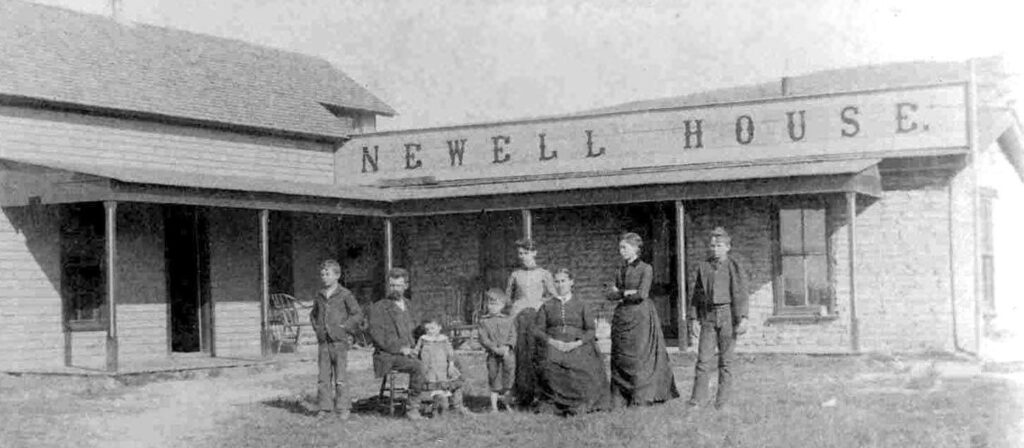
The Newell family circa 1884 in front of the sod home next to the sod hotel which Wick built in Wray, Colorado several years before coming to Washington by covered wagon.
A daughter born there was named Wray Darling Newell. In 1906 she married Howard McLeod of Langley.
Wick served as postmaster for the little town at $100 per annum.
It is a position he would later hold for a fourth time after moving to Useless Bay on South Whidbey.
Wick also helped to found the town’s newspaper, “The Wray Rattler” named after a large rattlesnake with 14 rattles he had shot and mounted as a trophy.
He was a masterful sharpshooter who frequently hunted antelope and deer to help feed local families, for by then the buffalo had nearly been wiped out.
In late 1888 the Newell family was on the move again. This time via covered wagon to Seattle by way of the Oregon Trail. Ever since the railroads had been built, use of the Trail had diminished, but was still being used.
January 8, 1889 was a bitterly cold day at Walter’s Ferry on the Snake River in Idaho where the Newells had made camp. Their eldest son, Arthur, age 16, took his rifle and went out to hunt game for the family. Then it began to snow. Hard. Arthur never returned.
According to the Boise City Statesman, a search party was formed. Six days later, his frozen body was found just a quarter mile from the camp. He is buried near the ferry site.
After a stay in Seattle where Wick worked as a surveyor, the Newells bought 10 acres in 1891 at Useless Bay on South Whidbey at what is now Bayview, though back then it wasn’t even yet called Bay View.
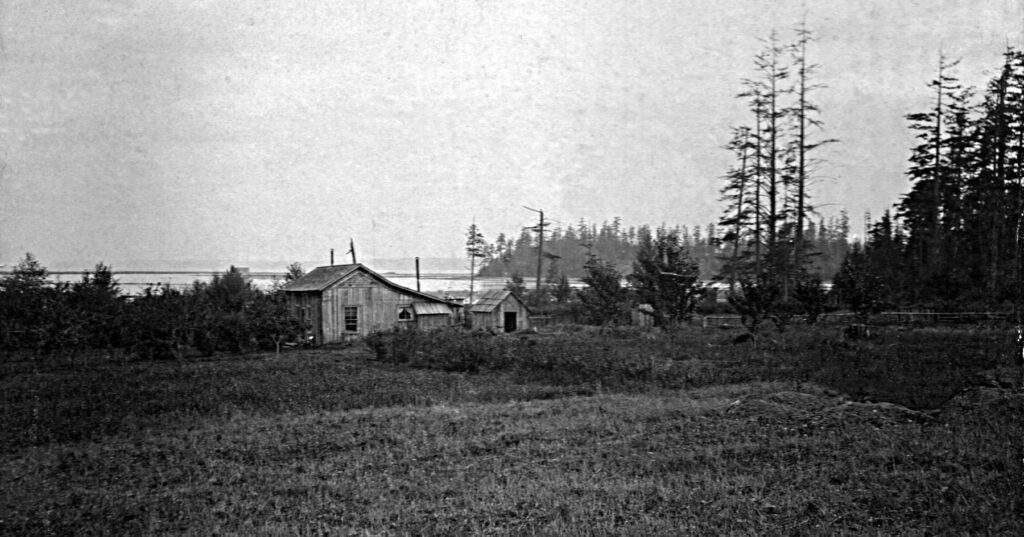
The Newells lived here from 1891 to 1904 before moving near Midvale and building the Newell Trout Hatchery a little south of Miller’s Lake (now Miller Lake). The house served as the post office for Newell, as the area was known as then. There was also a small store on the property. The front door is located to the left. Note the water in Deer Lagoon before it was diked. The house was on 10 acres of land (now mostly golf course and houses). Corydon and Ella Melendy purchased it in 1904.
There was no highway, nor even a road, save a wagon trail. No Bayview Corner. No Bayview School. No Bayview Hall. No Bayview Store. There was not yet even Ernie Meier’s first Bay View Cash Store established in 1905 on the lagoon between the Newell farmhouse and their nearest neighbors, the Weedins.
(The Weedins had come in 1885 and bought the old Joe Johnson logging camp. They lived in the bunkhouse while building their house and barn — still standing — and now owned by Whidbey Telecom.)
Two Newell children were born on South Whidbey: Elnorra in 1892 and the last child, Estella, in 1894 when Ellen was 44. (By this time one son and four daughters had died.)
Wick became the Postmaster for the area from 1894 to 1904, operating the post office out of his house, along with a small store built in 1898.
According to Mrs. Herb (Christine) Weedin in the 1939 Whidby Record, one of his daughters would ride her horse on a trail to Langley to pick up the mail. The Bayview area was known as ‘Newell’ until 1905 and appeared on early maps by that name.
Christine Weedin also wrote that Mr. Newell built a two-masted sloop which he sailed to Seattle for supplies. There were no dikes on the lagoon in those days, and at high tide a channel was navigable all the way up to where Highway 525 now runs.
In the 1892 census Wick is listed as being a farmer. By the time the 1900 census was taken, he was managing it as census enumerator for all of South Whidbey which included the three precincts of Useless Bay, Langley and Scatchet Head.
In July of 1904, the Newells sold their 10-acre farm to Corydon and Ella Mae Melendy, newly arrived from South Dakota. As late as the 1910 census, the Melendys are listed, along with the Weedins, as living on Newell Road which must have become the old highway (now a stretch of Mills Rd.), next to current Highway 525.
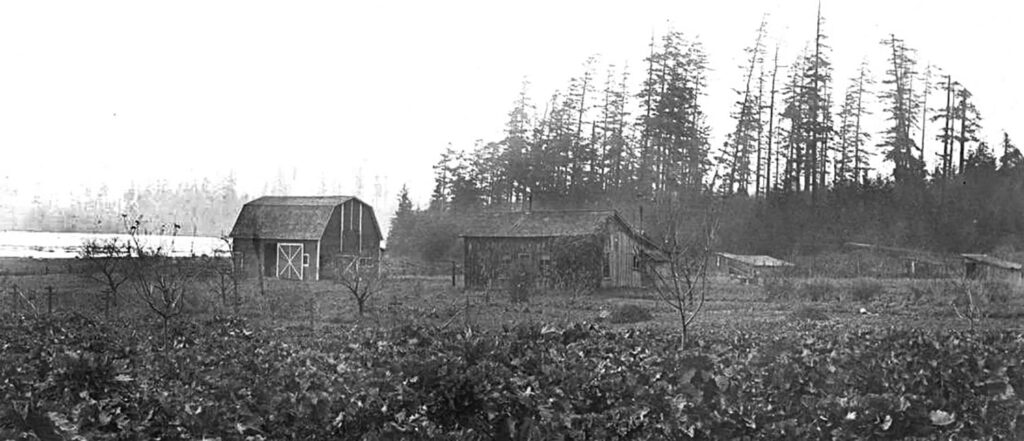
After selling their Bayview farm and house to the Melendys, the Melendys constructed a barn and planted apple trees before Corydon turned to raising chickens. They also discontinued the post office.
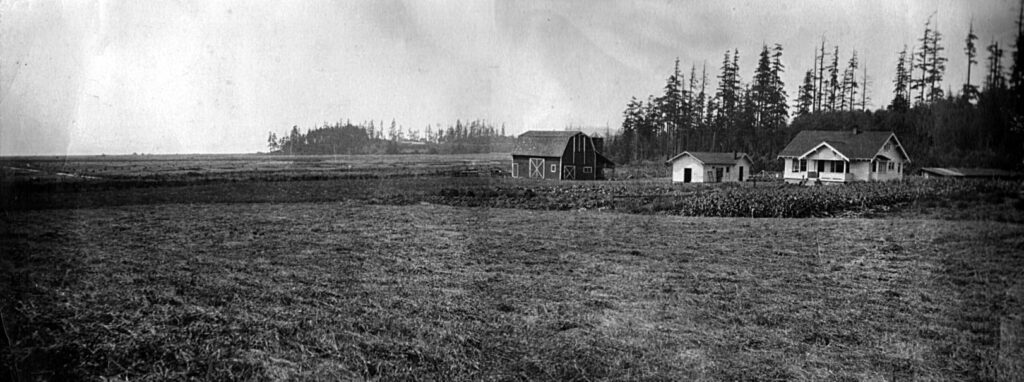
The Melendys built this 1922 craftsman-style house to replace the Newell house. Though the barn is gone, the house still stands and is now bordered by Useless Bay Golf Course and Highway 525.
The Newells built a combination fish hatchery and house just south of present Midvale on what became Maxwelton Road. This was a larger, second trout hatchery, and it is a unclear as to whether Wick had one at the Bayview property, or as was claimed by Cora Cook in a column about the Maxwelton Valley history in a 1951 article in the Whidbey Record, one near the old Calligan logging camp in the area, possibly off Midvale Road.
By 1905, it seems Wick had found the perfect setting for a larger trout hatchery and either bought or leased-to-own some land from Mr. Charles Feek.
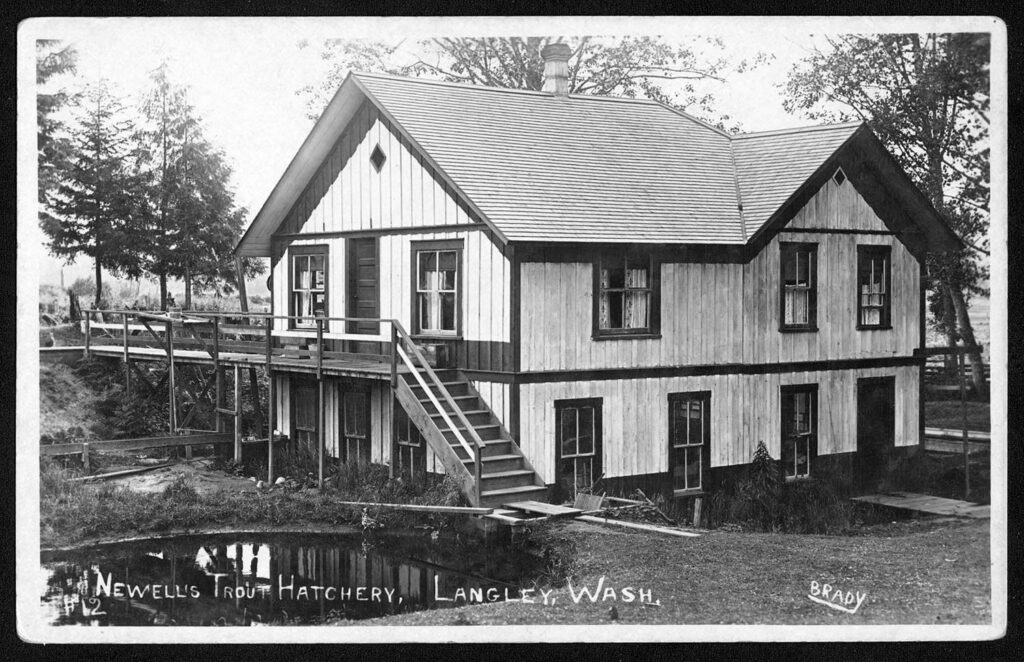
The Newell Trout Hatchery and home on Maxwelton Road as it looked about 1906. The hatchery was located on the bottom floor where the metal hatching trays were located. The creek still feeds into the pond (now smaller) and then by the side of the house. Photo credit: MOHAI, Ferdinand Brady Photographic Postcards, 1988.11.133. Used by permission.
The July 12, 1907 issue of The Island County Times, which was printed in Coupeville, gives the following account…
A Visit to Island County’s Fish Hatchery and Biggest Dairy Farm
by William T. Howard, Editor
The editor of a country weekly who rustles all the ‘copy’ for his paper, sets type, does job work, sets his ‘ads’, keeps his books, and collects bills and dozens of other things around the office has precious little time for recreation.
That is why, last Sunday, in company with the better half, Mr. and Mrs. R. McLeod and Mr. and Mrs. Ed Howard of Langley, visited the fish hatchery run by Mr. W. Newell and the large dairy farm run by Mr. Charles E. Feek, our county commissioner, both of which are about four and a half miles from Langley and an equal distance from Clinton.
The party drove out from Langley and found Mr. Newell and his estimable wife waiting to receive them at the hatchery where Mr. Newell stays to take care of the fish. Here we were joined by Mr. & Mrs. Feek and Mr. and Mrs. Howard McLeod and Roy Newell.
The fish hatchery was formerly on Mr. Newell’s own farm but as he could secure better water facilities, he has moved it onto Mr. Feek’s farm where a creek of fresh, pure water runs into a pond.
There is a fine alder grove here where over 850 people held the Fourth of July picnic this year, and as the platform where the dancers held forth had not been removed, a table was set there, and about one o’clock Mrs. Newell invited all to partake of a bountiful dinner which was eaten with great relish by the hungry crowd who had enjoyed the jolting ride through the woods.
After dinner the editor was taken by Mr. Feek in the buggy behind the family horse “Chub” and drove to his farm about a mile from the hatchery. And we wish to say right here that there are few around Coupeville who know what a magnificent farm Mr. Feek has.
Imagine, if you can, a rich bottom of 600 acres fed by numerous creeks of fine water, and where the soil is as rich as that of Ebey’s Prairie and you have some conception of this place. 100 acres of it are under cultivation and is used for raising hay and roots for his dairy cows; 250 acres are in pasture and the remainder uncleared, but a little is being cleared up each spring.
It is all ditched and fenced into different fields and Mr. Feek is building a lane 30 feet wide, to run around the entire farm, so that the cows can be driven to any pasture without trouble. He has about 130 head of cows and heifers, mostly Jerseys which he believes are the best dairy cows, and of which he is milking 47 head at the present time and often milks as high as 60 and 70.
The cream is separated at one end of the building where the cows are milked and a trip is made every day to Clinton where it is shipped to Seattle.
Mr. Feek has his feed for his milk cows all cut up green by a machine and put into an immense tank, or silo, which holds 180 tons. Here the feed keeps green, retains all its nutrients and keeps the cows fat and in good milk-giving condition with very little grain. The cows are all driven into stanchions and it is a pretty sight to see 47 of them with their heads through the bars, standing in a row, waiting to be milked.
Mr. Feek has his own threshing machine, blacksmith farm, and everything to work with on the farm, a nice clean bunkhouse with the best spring beds for the four hands, a cookhouse in a separate building, and a cook to do the work, so that his wife is not bothered with any of this kind of work. They have a fine farmhouse, built two years ago (1905) with a heating plant which stands on a rise overlooking the rest of the farm and presents a beautiful view of the valley land.
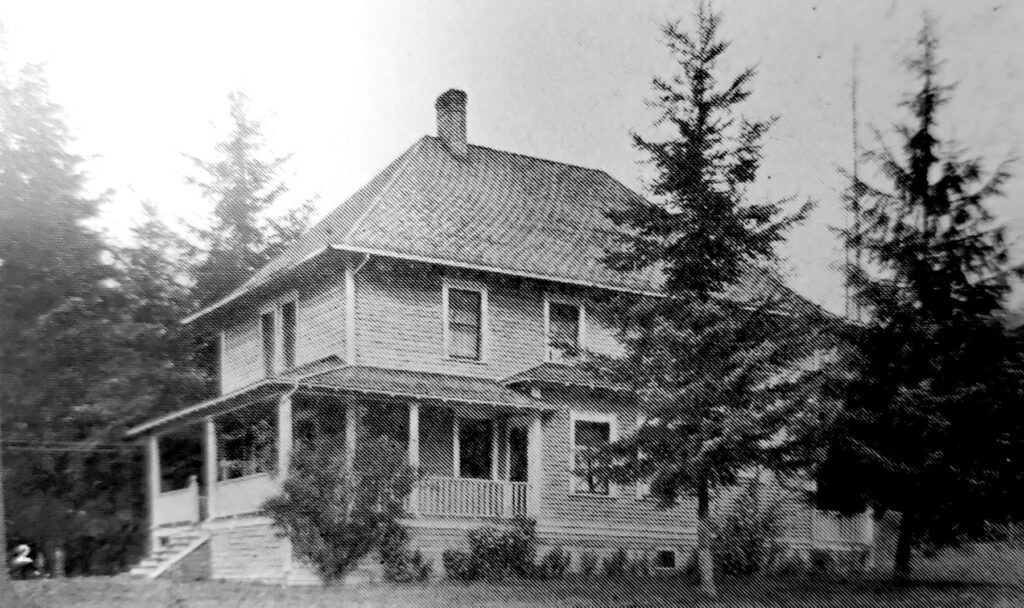
The Feeks were neighbors to the Newells and owned the property that Newell either bought or leased for the trout hatchery. Their farm is mentioned in the Island County Times story along with the Newell Trout Hatchery. (See post.) Built in 1905 for Charles and Sophie Feek, this mansion later became the home of Ralph Noble. Charles Feek was a prominent dairy farmer, a County Commissioner, and in 1908 the first president of the Whidbey Telephone Company. He came to Whidbey in 1… See more
We could easily write a column or two about this splendid Whidbey Island dairy farm and fine home which Mr. Feek has built up by untiring work and energy, but lack of space forbids…
Returning to the hatchery, we were shown the various ponds of fine speckled trout which Mr. Newell has hatched out in the last three years, having started about four years ago to get ready for the work. He is an experienced hand at the business having worked at the state hatchery previous to this and understands all its details.
The hatchery stands over a creek of fine, pure water which is conveyed to the troughs inside where the eggs are placed in wired trays and hatched out in March. After a certain growth they are placed in the upper pond of the creek. Below this is another pond, made by widening the creek, in which are the fish hatched out a year ago in March, and in a natural pond, into which the creek runs into below, are the larger and older fish.
They are fed meat and other things regularly by Mr. Newell and it is one of the most interesting sights we have ever seen to witness these speckled beauties jumping after the morsels of meat. The three hatches made by Mr. Newell has brought about 350,000 fish of which 130,000 were of this year, and next year he expects to hatch fully half a million.
A few have been sold this year and another year a large quantity will be disposed of, and regularly each year thereafter, as a new batch will be growing to the right size to take their place.
A ready sale can be found for all at forty cents a pound and it certainly looks as though Mr. Newell and his associates have a small fortune in this enterprise. It is certain that no better man could be found to run the business. He likes the work and has had remarkable success, losing less than two percent of the eggs placed in the hatchery, which is a record never equaled by state hatcheries.
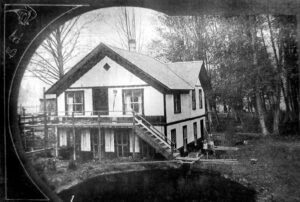
This is another view of the Newell Trout Hatchery that was in the 1911 “Whidbey – A World Beater” promotional booklet about the Island.
State Fish Commissioner Beebe, who visited Mr. Newell some time ago, stated in the Everett Herald that Mr. Newell was doing better work than is being done at the state fish hatchery.
With the facilities for the work in the shape of good water, location, etc. and the thorough understanding of the business, Mr. Newell is really just at the beginning of an enterprise which bids to assume big proportions in a few years and will give his hatchery a State reputation.
The time is well spent in visiting it and to one who has never seen a hatchery it is very interesting as well as profitable, which we can attest, and wish to say that in all our fifteen months’ residence on Whidby Island we have never spent a more pleasant day than the one at Mr. Newell’s and the visit to Mr. Feek’s dairy.
During the 1909 Alaska-Yukon-Pacific Exposition held in Seattle from June to mid-October, Wick was Island County’s representative with a trout hatchery exhibit in the Agriculture Building. The Expo drew 3.7 million visitors from around the world.
By 1911 the hatchery was producing 2 to 3 million mountain and cutthroat trout for sale to stock mountain lakes.
Success was tempered by more loss, however. In 1905 the Newells lost a seventh child, son DeWert, age 23, who died of heart failure.
Then in 1911, their second youngest daughter, Ella, died at age 19. (Cause of death is unknown at this time.) Only five of the 13 Newell children survived their parents.
In June 1913, Ellen died of what was termed a diabetic convulsion, after having been in decline for about a year. Her death was mourned by many in the South Whidbey community, as according to the Island County Times obituary: “She was a lady well and widely loved by hundreds throughout the county.”
A further tragedy took place the following April when their son Roy’s firstborn son, Ellery Chauney, age two, drowned in one of the ponds at the hatchery after being kicked by a horse.
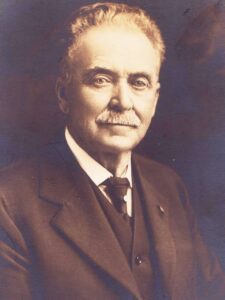
Wick Newell
On September 28, 1916 Wick married a 44-year-old widow named Mary ‘Mae’ Case. In the 1920 census they are listed as living at the hatchery. Ill health may have brought them to a veterans home in Everett where Mae subsequently died.
Wick remarried in 1922 to Nettie Thibault Crockett Camp, a widow from Seattle who had also been married to a Civil War veteran.
Wick died in 1932 at the age of 85. He is buried next to his first wife, Ellen, in Bayview Cemetery.
The hatchery was sold to Charles and Anna Quade around 1920. They continued to run it for at least a decade or more before moving farther down Maxwelton Rd. to what became Quade Rd.
About half of the dwelling is still standing. The bottom story where the eggs were hatched was removed, so that it is only a one-story house now and has been added onto. The creek still runs right alongside the house, though the main pond is smaller, and there are only wide places in the creek now where the two additional holding ponds had been created.
The current renter said that for several years he saw salmon spawning in the creek until silt increased likely due to uphill earth moving that made it shallower. The water, he says, is the coldest of any creek on the South end and still flows year round.
In October of 2014, Newell family descendants gathered at Bayview Cemetery to honor Wickliff by unveiling a headstone honoring his Union Army Civil War service.
Wick and Ellen Newell witnessed some of the greatest changes in our nation’s history and built a sustainable living on South Whidbey. Neither had a formal education and were home-schooled and self-educated. They epitomized the hard-working ethos of many early settlers and those who came after.

Members of the Newell family unveiled a Civil War veteran headstone in 2014 for family patriarch Wickliff(e) Newell. On the far right from top to bottom are three generations of Wickliffe Guy Newells: IV, III, and V. (Photo by Kate Daniel/ The Record)
* Wickliff(e) often dropped the ‘e’ when signing his name, but the traditional ancestral family spelling is ‘Wickliffe.’
** Thanks to the Newell family for providing information and several of the family photos.
If you like reading in-depth stories about the history of South Whidbey and its people, consider joining the South Whidbey Historical Society at
www.southwhidbeyhistory.org/join 












